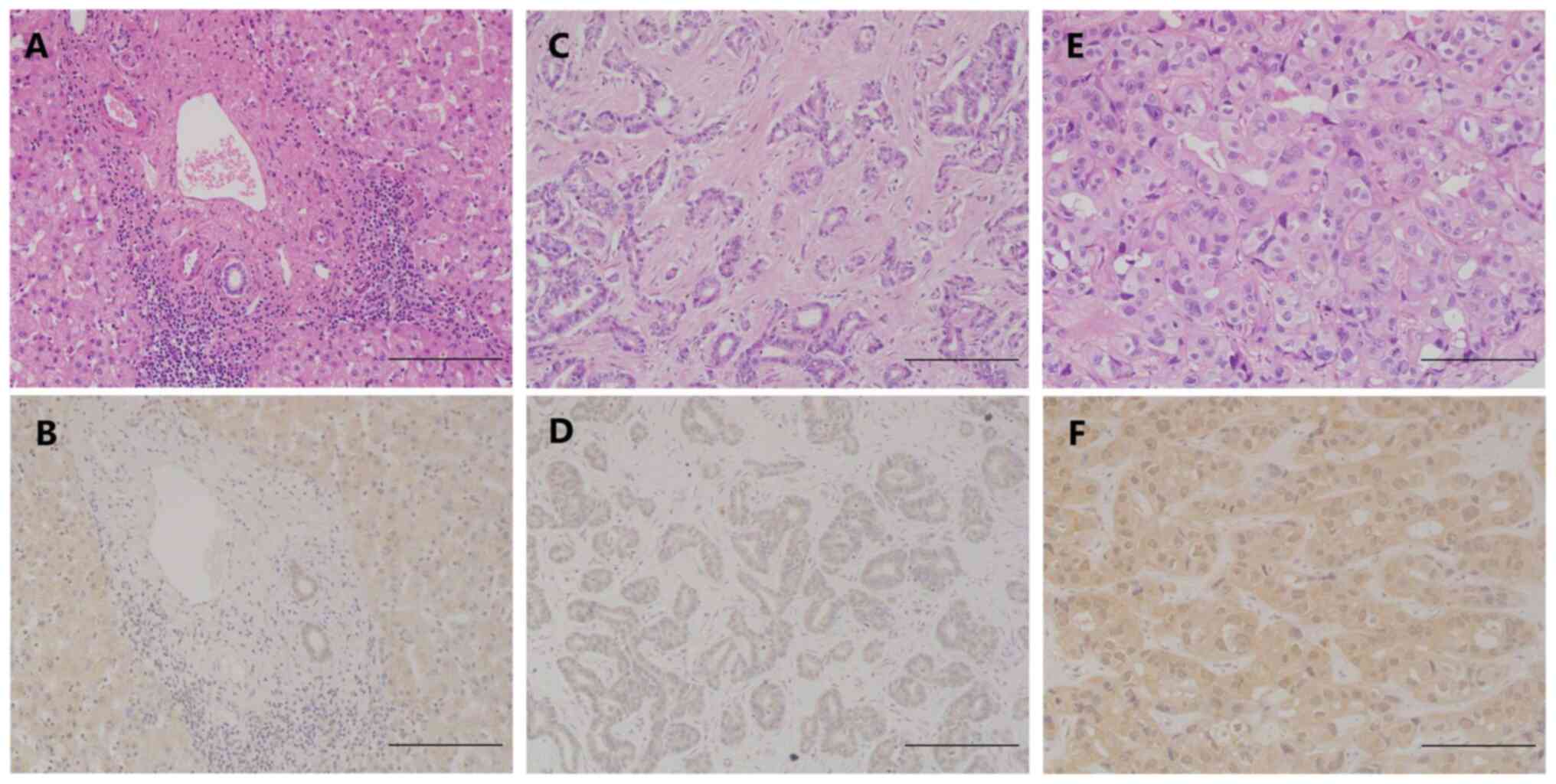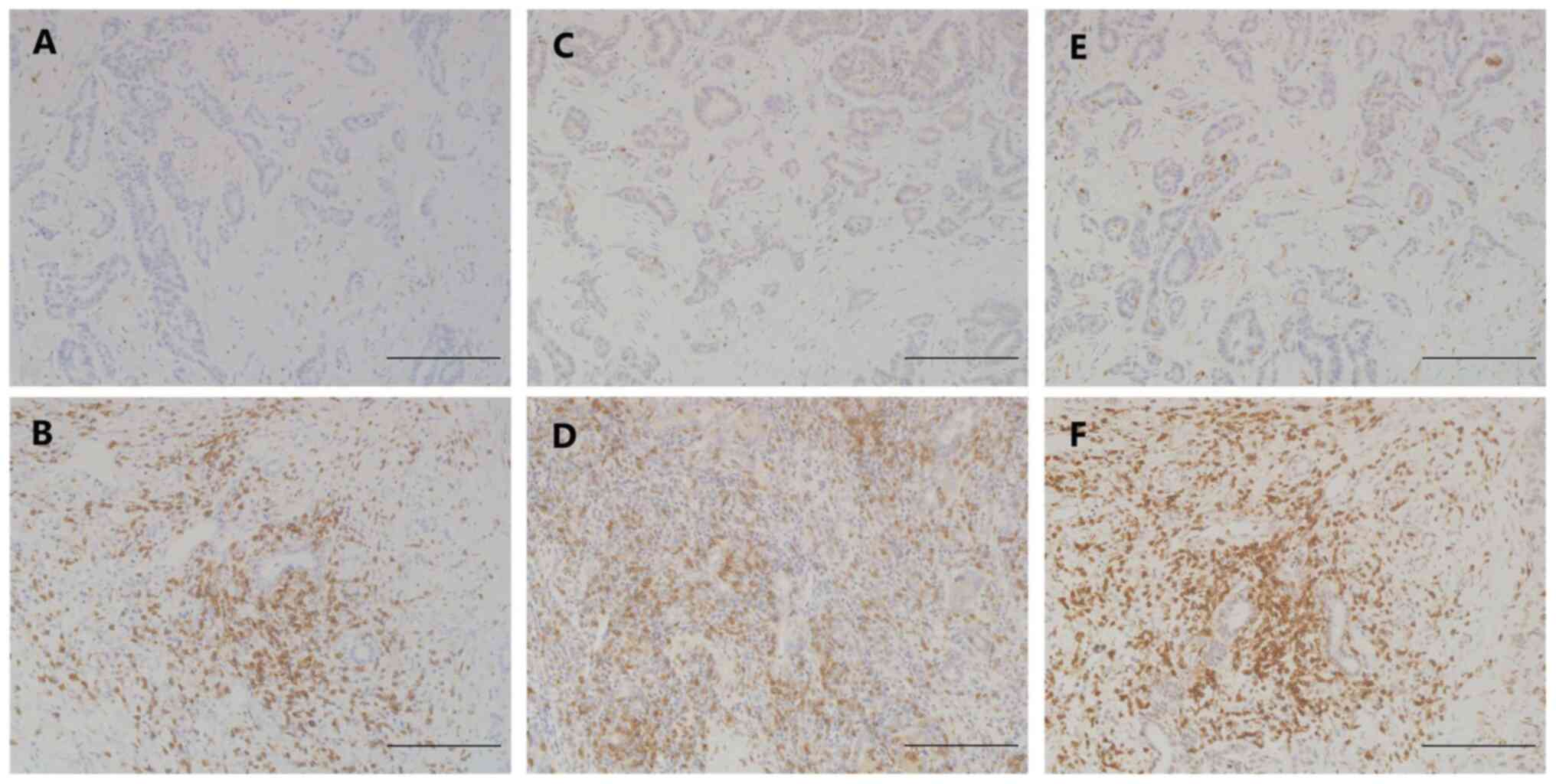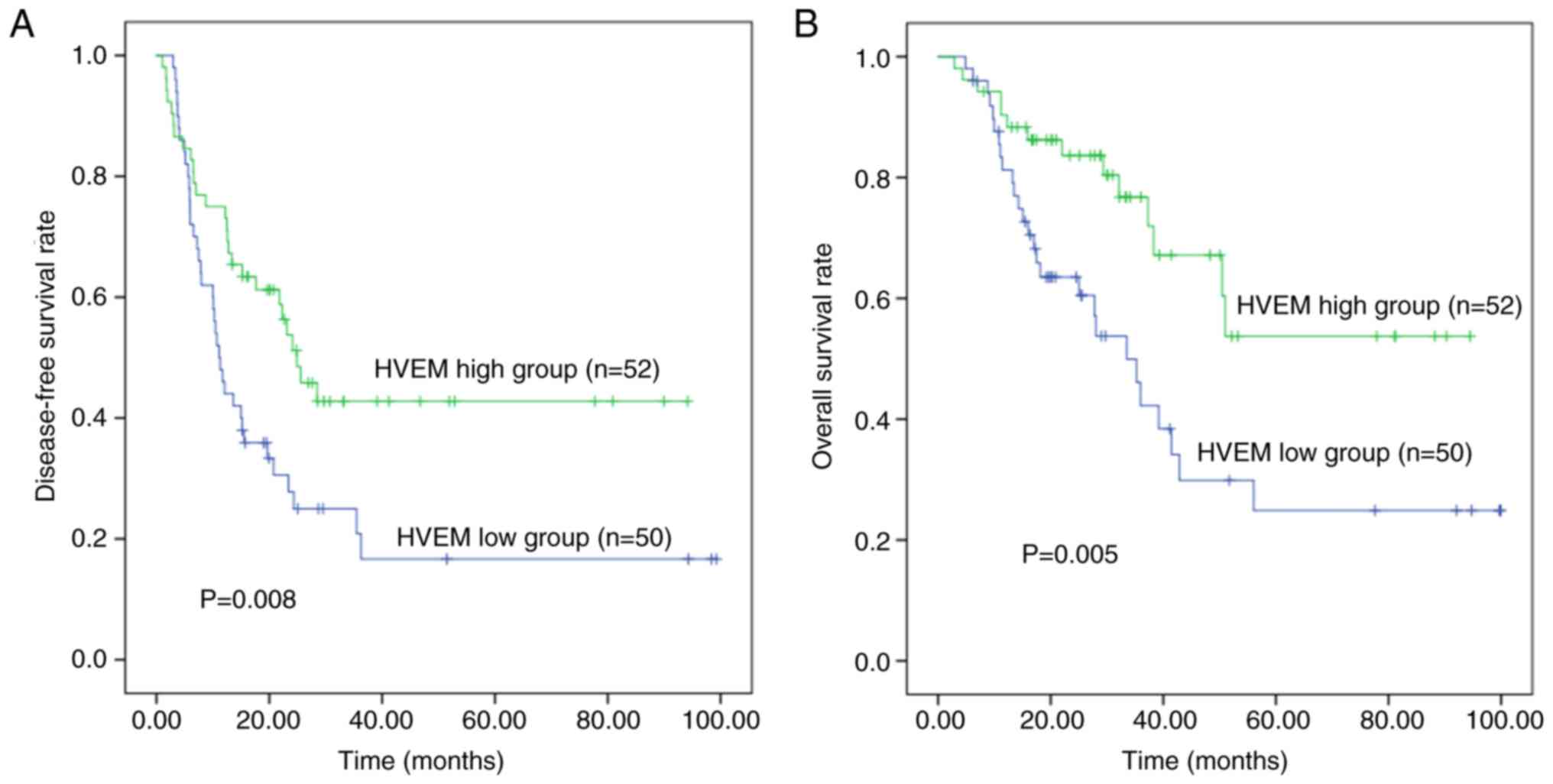|
1
|
Bergquist A and von Seth E: Epidemiology
of cholangiocarcinoma. Best Pract Res Clin Gastroenterol.
29:221–232. 2015. View Article : Google Scholar : PubMed/NCBI
|
|
2
|
Mavros MN, Economopoulos KP, Alexiou VG
and Pawlik TM: Treatment and prognosis for patients with
intrahepatic cholangiocarcinoma: Systematic review and
meta-analysis. JAMA Surg. 149:565–574. 2014. View Article : Google Scholar : PubMed/NCBI
|
|
3
|
Gonzalez-Carmona MA, Bolch M, Jansen C,
Vogt A, Sampels M, Mohr RU, van Beekum K, Mahn R, Praktiknjo M,
Nattermann J, et al: Combined photodynamic therapy with systemic
chemotherapy for unresectable cholangiocarcinoma. Aliment Pharmacol
Ther. 49:437–447. 2019. View Article : Google Scholar : PubMed/NCBI
|
|
4
|
Bridgewater J, Galle PR, Khan SA, Llovet
JM, Park JW, Patel T, Pawlik TM and Gores GJ: Guidelines for the
diagnosis and management of intrahepatic cholangiocarcinoma. J
Hepatol. 60:1268–1289. 2014. View Article : Google Scholar : PubMed/NCBI
|
|
5
|
Rizvi S, Khan SA, Hallemeier CL, Kelley RK
and Gores GJ: Cholangiocarcinoma-evolving concepts and therapeutic
strategies. Nat Rev Clin Oncol. 15:95–111. 2018. View Article : Google Scholar : PubMed/NCBI
|
|
6
|
Martin-Liberal J, Ochoa de Olza M, Hierro
C, Gros A, Rodon J and Tabernero J: The expanding role of
immunotherapy. Cancer Treat Rev. 54:74–86. 2017. View Article : Google Scholar : PubMed/NCBI
|
|
7
|
Montgomery RI, Warner MS, Lum BJ and Spear
PG: Herpes simplex virus-1 entry into cells mediated by a novel
member of the TNF/NGF receptor family. Cell. 87:427–436. 1996.
View Article : Google Scholar : PubMed/NCBI
|
|
8
|
Kwon BS, Tan KB, Ni J, Oh KO, Lee ZH, Kim
KK, Kim YJ, Wang S, Gentz R, Yu GL, et al: A newly identified
member of the tumor necrosis factor receptor superfamily with a
wide tissue distribution and involvement in lymphocyte activation.
J Biol Chem. 272:14272–14276. 1997. View Article : Google Scholar : PubMed/NCBI
|
|
9
|
Šedý JR and Ramezani-Rad P: HVEM network
signaling in cancer. Adv Cancer Res. 142:145–186. 2019. View Article : Google Scholar : PubMed/NCBI
|
|
10
|
Ritthipichai K, Haymaker CL, Martinez M,
Aschenbrenner A, Yi X, Zhang M, Kale C, Vence LM, Roszik J,
Hailemichael Y, et al: Multifaceted Role of BTLA in the control of
CD8(+) T-cell Fate after Antigen Encounter. Clin Cancer Res.
23:6151–6164. 2017. View Article : Google Scholar : PubMed/NCBI
|
|
11
|
Sideras K, Biermann K, Yap K, Mancham S,
Boor PPC, Hansen BE, Stoop HJA, Peppelenbosch MP, van Eijck CH,
Sleijfer S, et al: Tumor cell expression of immune inhibitory
molecules and tumor-infiltrating lymphocyte count predict
cancer-specific survival in pancreatic and ampullary cancer. Int J
Cancer. 141:572–582. 2017. View Article : Google Scholar : PubMed/NCBI
|
|
12
|
Hokuto D, Sho M, Yamato I, Yasuda S, Obara
S, Nomi T and Nakajima Y: Clinical impact of herpesvirus entry
mediator expression in human hepatocellular carcinoma. Eur J
Cancer. 51:157–165. 2015. View Article : Google Scholar : PubMed/NCBI
|
|
13
|
Migita K, Sho M, Shimada K, Yasuda S,
Yamato I, Takayama T, Matsumoto S, Wakatsuki K, Hotta K, Tanaka T,
et al: Significant involvement of herpesvirus entry mediator in
human esophageal squamous cell carcinoma. Cancer. 120:808–817.
2014. View Article : Google Scholar : PubMed/NCBI
|
|
14
|
Lan X, Li S, Gao H, Nanding A, Quan L,
Yang C, Ding S and Xue Y: Increased BTLA and HVEM in gastric cancer
are associated with progression and poor prognosis. Onco Targets
Ther. 10:919–926. 2017. View Article : Google Scholar : PubMed/NCBI
|
|
15
|
Tang M, Cao X, Li Y, Li GQ, He QH, Li SJ,
Chen J, Xu GL and Zhang KQ: High expression of herpes virus entry
mediator is associated with poor prognosis in clear cell renal cell
carcinoma. Am J Cancer Res. 9:975–987. 2019.PubMed/NCBI
|
|
16
|
Zhang T, Ye L, Han L, He Q and Zhu J:
Knockdown of HVEM, a lymphocyte regulator gene, in ovarian cancer
cells increases sensitivity to activated T cells. Oncol Res.
24:189–196. 2016. View Article : Google Scholar : PubMed/NCBI
|
|
17
|
Fang Y, Ye L, Zhang T, He QZ and Zhu JL:
High expression of herpesvirus entry mediator (HVEM) in ovarian
serous adenocarcinoma tissue. J BUON. 22:80–86. 2017.PubMed/NCBI
|
|
18
|
Tsang JYS, Chan KW, Ni YB, Hlaing T, Hu J,
Chan SK, Cheung SY and Tse GM: Expression and clinical significance
of herpes virus entry mediator (HVEM) in breast cancer. Ann Surg
Oncol. 24:4042–4050. 2017. View Article : Google Scholar : PubMed/NCBI
|
|
19
|
Malissen N, Macagno N, Granjeaud S,
Granier C, Moutardier V, Gaudy-Marqueste C, Habel N, Mandavit M,
Guillot B, Pasero C, et al: HVEM has a broader expression than
PD-L1 and constitutes a negative prognostic marker and potential
treatment target for melanoma. Oncoimmunology. 8:e16659762019.
View Article : Google Scholar : PubMed/NCBI
|
|
20
|
Ma B, Meng H, Tian Y, Wang Y, Song T,
Zhang T, Wu Q, Cui Y, Li H, Zhang W and Li Q: Distinct clinical and
prognostic implication of IDH1/2 mutation and other most frequent
mutations in large duct and small duct subtypes of intrahepatic
cholangiocarcinoma. BMC Cancer. 20:3182020. View Article : Google Scholar : PubMed/NCBI
|
|
21
|
Kang J, Jeong JH, Hwang HS, Lee SS, Park
DH, Oh DW, Song TJ, Kim KH, Hwang S, Hwang DW, et al: Efficacy and
Safety of Pembrolizumab in patients with refractory advanced
biliary tract cancer: Tumor proportion score as a potential
biomarker for response. Cancer Res Treat. 52:594–603. 2020.
View Article : Google Scholar : PubMed/NCBI
|
|
22
|
Dobosz P, Stempor PA, Roszik J, Herman A,
Layani A, Berger R, Avni D, Sidi Y and Leibowitz-Amit R: Checkpoint
genes at the cancer side of the immunological synapse in bladder
cancer. Transl Oncol. 13:193–200. 2020. View Article : Google Scholar : PubMed/NCBI
|
|
23
|
Tamada K, Shimozaki K, Chapoval AI, Zhu G,
Sica G, Flies D, Boone T, Hsu H, Fu YX, Nagata S, et al: Modulation
of T-cell-mediated immunity in tumor and graft-versus-host disease
models through the LIGHT co-stimulatory pathway. Nat Med.
6:283–289. 2000. View
Article : Google Scholar : PubMed/NCBI
|
|
24
|
Zhao Q, Zhang GL, Zhu X, Su D, Huang ZL,
Hu ZX and Peng L: The paradoxical changes of membrane and soluble
herpes virus entry mediator in hepatocellular carcinoma patients. J
Gastroenterol Hepatol. 32:1520–1524. 2017. View Article : Google Scholar : PubMed/NCBI
|
|
25
|
Liu J, Li J, He M, Zhang GL and Zhao Q:
Distinct changes of BTLA and HVEM expressions in circulating
CD4+ and CD8+ T cells in hepatocellular
carcinoma patients. J Immunol Res. 2018:45615712018. View Article : Google Scholar : PubMed/NCBI
|
|
26
|
Komuta M, Govaere O, Vandecaveye V, Akiba
J, Van Steenbergen W, Verslype C, Laleman W, Pirenne J, Aerts R,
Yano H, et al: Histological diversity in cholangiocellular
carcinoma reflects the different cholangiocyte phenotypes.
Hepatology. 55:1876–1888. 2012. View Article : Google Scholar : PubMed/NCBI
|
|
27
|
Liau JY, Tsai JH, Yuan RH, Chang CN, Lee
HJ and Jeng YM: Morphological subclassification of intrahepatic
cholangiocarcinoma: Etiological, clinicopathological, and molecular
features. Mod Pathol. 27:1163–1173. 2014. View Article : Google Scholar : PubMed/NCBI
|
|
28
|
Jiao Y, Pawlik TM, Anders RA, Selaru FM,
Streppel MM, Lucas DJ, Niknafs N, Guthrie VB, Maitra A, Argani P,
et al: Exome sequencing identifies frequent inactivating mutations
in BAP1, ARID1A and PBRM1 in intrahepatic cholangiocarcinomas. Nat
Genet. 45:1470–1473. 2013. View Article : Google Scholar : PubMed/NCBI
|
|
29
|
Peña-Llopis S, Vega-Rubín-de-Celis S, Liao
A, Leng N, Pavía-Jiménez A, Wang S, Yamasaki T, Zhrebker L,
Sivanand S, Spence P, et al: BAP1 loss defines a new class of renal
cell carcinoma. Nat Genet. 44:751–759. 2012. View Article : Google Scholar : PubMed/NCBI
|

















